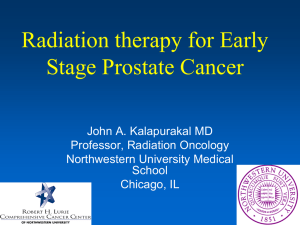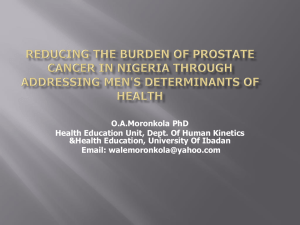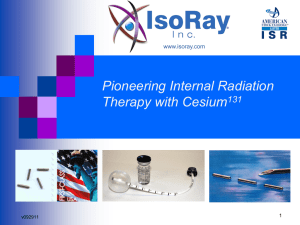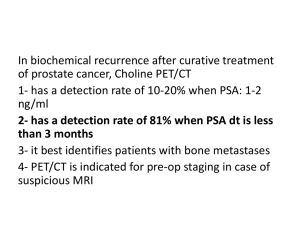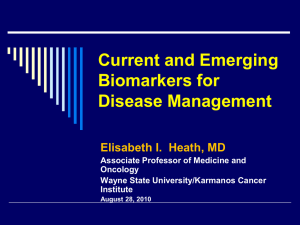to view Part 1 of the lecture. - Healing and Cancer Foundation
advertisement
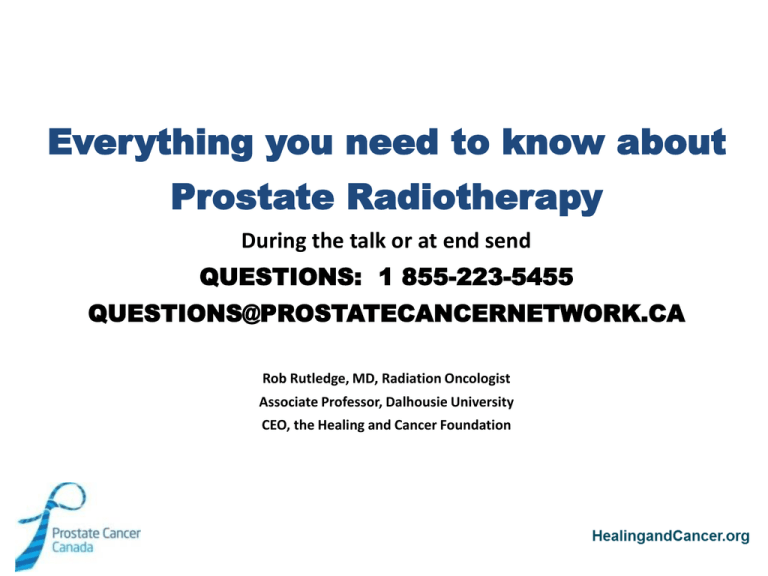
Everything you need to know about Prostate Radiotherapy During the talk or at end send QUESTIONS: 1 855-223-5455 QUESTIONS@PROSTATECANCERNETWORK.CA Rob Rutledge, MD, Radiation Oncologist Associate Professor, Dalhousie University CEO, the Healing and Cancer Foundation OVERVIEW OF TALK • • • • • • • Complete prostate cancer care Staging of curative prostate cancer Treatment options by extent of cancer Radiation after surgery Role of hormone therapy and chemotherapy Radiation for palliation Questions and answers COMPLETE PROSTATE CANCER CARE • • • • • • • • • • • Information: How to negotiate the medical system Understanding prostate cancer and its treatment Advice on complementary therapy Medical care – Surgery, Radiotherapy… Other medical system care: rehab, dietician, physio… Psychosocial specialist for those with high distress Empowering the person: body/ mind/ spirit Body - Exercise, diet, weight, sleep, relaxation Mind – Skills, stress-reduction, support Spirit - awareness, nurturing what’s most important PROSTATE CANCER ISSUES • 95% will live for 10 years • No agreed upon guidelines • The urologist is the first person to outline treatment options • Lack of clinical trials What is prostate cancer: A layperson’s guide WHAT IS PROSTATE CANCER? • Normal prostate cell that has begun to grow in a fast and uncontrolled way • Requires dozens of changes to a normal prostate cell • Cancer cells will grow into normal tissue • After more changes can get into lymph and blood system to grow colonies at a distance (metastasis) HOW A TUMOUR GROWS • • • • A tumour is a collection of cancer cells A tumour starts as one cancer cell 1 cell then 2 then 4 then 8 ….. Tumour growth if more cells are made than die • Tumour doubles in size over 1-3 years or longer • Tumour - 1 cm in size has a billion cells HOW PROSTATE CANCERS CAUSE PROBLEMS • Problem in the prostate – Narrow the tubing – urinate more often and – Slowing of stream • Spread to lymph nodes – uncommon • Spread to other parts of body especially bones • Affect whole body - fatigue Factors determining Treatment Options • How advanced is the cancer (staging) – Curable or not • Factors in curable prostate cancer – – – – PSA – blood test Rectal exam (T stage) How aggressive is the cancer (Gleason Score) How much cancer was seen on biopsy (# cores, % cancer in each core) • Fitness of the man • What does the man want? Prostate Specific Antigen - PSA • A chemical produced by both normal prostate cells and prostate cancer cells • Inflammation / infection of the normal prostate cells causes the PSA to increase – Whether or not prostate cancer cells are present – Explains why the PSA can bounce up and down • Excellent marker of cancer after diagnosis – PSA should be undetectable after surgery – PSA should be low after radiotherapy PSA does not localize cancer cells • Prostate cancer cells produce PSA no matter where they are in the body • A rapidly rising PSA and a very high PSA likely means there are cancer cells beyond the prostate area – Eg. PSA doubling time < 3 months or PSA >50 MAKING THE DIAGNOSIS • Biopsy - take a piece of tumor and look under microscope • 8-12 cores of tissue – each measuring 1cm by 0.1cm • This is a tiny sampling of the prostate gland • May miss cancer completely • May miss more aggressive cancer Gleason Score: How aggressive is the cancer? • • • • • Score is out of 10 Made up of two grades or patterns, each out of 5 First grade is the most common cancer seen Second grade is the second most common cancer Gleason score 6 or less is slow growing – Example 3/5 plus 3/5 • Gleason score 8 or more is fast growing • Gleason 7 is neither fast nor slow T STAGE – felt on rectal exam DRE: T1= No lump felt STAGING OF POTENTIALLY CURABLE PROSATE CANCER • Rectal exam - T1C, T2, T3/4 • PSA - <10, 10-20, >20. – How quickly it has increased • Gleason score • How much cancer is seen on the biopsy – Number of cores involved, and percent cancer • Optional tests for advanced disease: – Bone scan, Cat scan TREATMENT OPTIONS FOR PROSTATE CANCER Watch +/hormones Curable At Diagnosis NonCurable Watch +/treat for cure later TREAT NOW for cure Active Surveillance • Watch, and if need be treat for cure later • Means watching PSA and re-biopsy of prostate every 1-2 years • Go on to curative Rx if PSA jumps quickly, urinary symptoms, or biopsy shows worsening cancer • Best for men with very slow growing cancers whose life expectancy is less than 15 years Low-risk prostate cancer • Cancer is VERY LIKELY restricted to the prostate gland • Must have T2 (or less) and PSA <10 and Gleason Score 6 (or less) • Expect 80-95% chance of cure with treatment • Active surveillance is good option for many Low-risk prostate cancer T1/T2 and PSA<10 and GS<7 Surgery Therapy Low risk Surveillance Seed implant External Radiotherapy Treatment for cure: operation • Radical prostatectomy – removes the prostate and seminal vesicles • Has a specific side effects – – – – Related to major operation Urinary incontinence 5-10% Erectile dysfunction 30-70% Bladder neck stricture 10% • Is an excellent option in a situation where prostate cancer cells are likely restricted to the prostate gland • Removing the prostate gland provides much more information about the aggressiveness and extent of cancer • Radiotherapy can be used after surgery if it looks like cancer is likely left behind in the surgical bed or if PSA begins to rise in follow up Treatment of cure: Radioactive seeds in prostate • Also called Low Dose Rate or Seed Brachytherapy • Best for men with early disease when cancer cells likely in prostate gland of just beyond capsule • Very high cure rates similar to operation when done by an experienced specialist • “Simple” outpatient procedure – General anaesthetic – Rapid return to normal activity – Men appear happy with this treatment Seed Brachytherapy Advantages • Technical: – ultimate in dose escalation – 140 Gray – rapid dose fall-off in surrounding tissues (ultimate conformal) – avoid external RT problems of target motion, setup variation and localization errors Selection for Seed Brachytherapy • Low risk cancer and early intermediate risk – Shifting beyond low risk (GS 6, PSA<10, T1/2) • • • • Prostate less than 50-60cc in size Reasonable urinary stream Can undergo general anaesthesia No preexisting rectal fistula or rectal surgery – Need to have good rectal ultrasound pictures • +/- previous pelvic radiotherapy • +/- inflammatory bowel disease • +/- prior TURP (ream out of prostate) Brachytherapy planning • All patients require dosimetric planning prior to implantation – 2-3 weeks before or intra operatively • May not be able to get the needles into prostate • May try again after 3-6 months of hormones – Get 30% reduction in volume Volume study geometry Measuring needle penetration Needle tip at C4 Side Effects of Seed Brachy • Urinary – Irritative and obstructive symptoms for 3-6 months • Worse than with EBRT – 1 in 10 needs catheter, temporarily – ~85% will normalize within 1 year – Incontinence rare • Usually “urgency” incontinence • Rectal – Even mild toxicities are rare – 1 in 1000 risk of breakdown • Erectile function – 80-85% will maintain erectile function afterwards Treatment of Side Effects of Seed Brachytherapy • Pill for urinary flow (alpha blockers) prolonged • Anti-inflammatories • Watch out for urinary tract infections • 15-20% incontinence if TURP (ream out) after implant • Erectile dysfunction (15-20%) can be treated with pills PSA bounce after Brachytherapy • Rise in PSA > 0.2 ng/mL (later than 3 months) and subsequent drop without intervention • 1/3 of men will get this – More likely if young, good erectile function, “hot” implant • Usually within first 18 months – Though not necessarily • PSA can rise well above its lowest + 2 ng/mL • No biopsy within 3 years!! Treatment for cure: External radiotherapy • Technology has advanced in last few years to allow very high dose of radiotherapy to gland while minimizing dose to surrounding tissue • Especially good for situations in which prostate cancer cells beyond capsule of the prostate but not spread elsewhere CT SIMULATION The Issue of Target Margin around prostate • The target is the prostate gland PLUS areas where cancer cells may have spread • Also have to account for set up error and motion of the prostate gland – Men need to have same degree of filling in bladder – Bowel movement prior to simulation and treatment daily • Gold seeds can be inserted in prostate to localize prostate during treatment • The front rectum, bottom of bladder and urethra DOSIMETRY Prostate + Pelvic Lymph Nodes Simultaneous Integrated Boost TREATMENT

